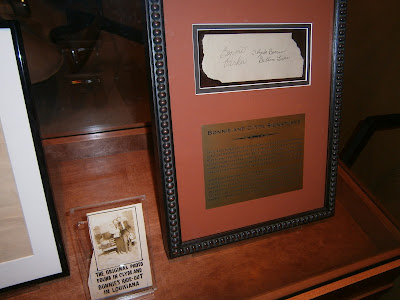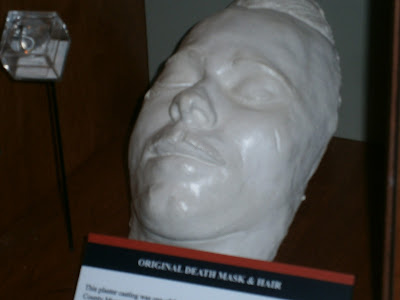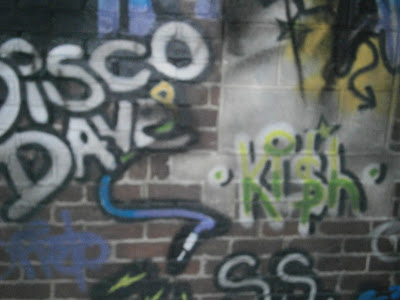Other than the usual attractions in DC such as the White House and the Lincoln Memorial, I found a place on my first day there that I wanted to see before I left town. It was when I first arrived and found myself roaming around looking for a place to have dinner after getting off the Gallery Place/Chinatown stop on the metro. Its called the Museum of Crime & Punishment, and since it was nearing closing time when I saw it originally, I planned on returning to the area earlier the next day to step inside.






Unfortunately I overslept and wasn't able to reach that part of town until about the time lunch hours was about to begin. Since my breakfast options at the Motel 6 was limited to a complimentary cup of coffee and a plastic straw, I was going to have to grab something to eat before going to the museum. While walking around I saw a store with the word "BALLS" written on the written. It seemed interesting enough for a closer look, then I discovered the smaller word of "meat" written above that. Meatballs sounded like a reasonable option; it could be breakfast enough without being too much of a lunch. I was probably one of their first customers of the day as the place was empty, except for a few workers. They give you the option of eating the meatballs over a dish of pasta, or in a sandwich wedge. Plus, there are four different type of balls: beef, chicken, vegan (with godknowswhat in it), and lamb (costs a few bucks extra). Finally, you choose between spicy red or marina for your sauce. I kept it rather simple with beef meatballs with spicy red sauce as a twist, in a wedge sandwich, with a bottle of iced tea. It was a bit pricey for a meatball sub, the total with the drink came out to $13. It tasted great and the benefit going being so early in the day was that the bread was nice and soft. With food out of the way, I needed to turn my attention to the killers and criminals around the corner at the museum.
I was getting used to all the museums and government buildings being free of charge for admittance that I felt strange having to pay to get inside. The entry fee is $23 and they make their cashiers shamefully dress in orange prison jump suits. If you didn't know any better, it would look like those cashiers escaped from some nearby crashed prison bus and are now robbing the cash register. The building itself isn't very large and you begin at the top floor and work your way down through the gift shop (as usual) and out the exit. There's a few free sneak peaks in the lobby such as a wax statue of legendary FBI Director J. Edgar Hoover with his tie uncharacteristically crooked and a Beetle vehicle that was once owned by legendary serial killer Ted Bundy. The museum not only focuses on the criminals, as the name of the place states, it's also about the laws and methods of punishment that have been dished out over history. Starting out in the Dark Ages, there's friendly tools such as a hot poker for peoples' tongues or a device to make people swallow water until they nearly drown. The tongue tool was especially used on suspected witches so they would be too badly injured to speak clearly enough to chant a magical spell. Another popular practice was tying each of the four major limbs to four different horses and have them literally pull the subject apart into different pieces (and they always say people used to be nicer to each other in the past).
When it came time to see the pirate section I was surprised to find out that there were a few women pirates, both openly as women and some dressed up as men in secret. During the time of the Old West there seemed to be alot of ambiguity between the sides of good and bad. Wyatt Earp is always considered a righteous lawman in the history books, but what isn't too well know was that once he started up a posse to chase after the cowboys who had shot two of his brothers, made famous in the 1993 film "Tombstone", Earp himself was pursued by a posse of lawmen looking to put an end to his act of vigilantism. A few of Earp's personal possessions, such as one of his guns, was on display, as well as items from other famous figures of that time including Jesse James and Wild Bill Hickok. Next period highlighted was what I was most looking forward to; that's the bank robbing desperadoes during the Great Depression and the early days of what is known as the mob. At first I saw a bullet ridden car that looked like the one Bonnie and Clyde were killed in, but it turned out it was only a replica model car and not the actual one. In relation to that, there was an old Ford ad that actually boasted on the fact that John Dillinger used a Ford to make his getaways. Bank robbers such as Bonnie & Clyde and the Dillinger gang had the advantage over local law enforcement in three different aspects. One was that they drove cars with supped up engines such as the Ford V-8 that allowed them to speed away from standard police vehicles. Another was that before the FBI and certain federal laws were created, bank robbers had the benefit of only having to cross the state line to escape arrest. State and local authorities were not allowed to cross into another state to chase suspects, and as long as the suspects didn't do anything wrong in the next state, that state couldn't arrest them for a crime committed in a different state.
The method back then was to rob a bank, speed across the state line, lay low until the heat was off, and then cross into a different state to rob a new bank. The last advantage the bank robbers of that era had was the firepower. In addition to robbing banks, it was very popular to rob armories and military bases to obtain high-powered weapons to over-match simplistic police pistols. In the early days of the FBI, the agents couldn't carry any weapons, and it took time for them to even be authorized to carry pistols. Soon enough laws were created to allow the FBI to have guns to match the bandits as well as the authority to chase after crooks fleeing across state lines. While that was occurring in the Midwest, in American cities there was the mob. There was memorabilia from the Lexington Hotel that served as the headquarters for Al Capone, a beer bottle from a Dutch Schultz brewery, and a signed check from Carlo Gambino, who apparently did his banking at Chase Manhattan. Since mob life is a popular topic with Hollywood, there were plenty of items used in actual movies such as an uzi from the 1983 film "Scarface" that was handled by Al Pacino before he switches to his bigger M-16 with grenade launcher and goes into his "Say hello to my little friend" rampage. From the king of mafia films, 1972's "The Godfather", there's a handgun from the scene where the character Luca Brasi puts on a bulletproof vest and gets dressed for a mob meeting. There was another handgun that was used for James Caan's character, but it doesn't appear in the film. The last piece of movie memorabilia worth noting was Kevin Coster's gun from his role as Elliot Ness in the 1987 film "The Untouchables". Brian DePalma was the director of both "Scarface" and "The Untouchables".
Things began to get creepy once it got to the serial killers and murderers of famous people. There wasn't much for Charles Manson except for some sketches and a letter to a pen pal he had in Rego Park, Queens. The most attention went towards the killer clown, John Wayne Gacy. Not only did they have some of his clown suits he used to dress up in for local neighborhood block parties, but they also had some of the clothes and personal items found on him the day he was arrested. The biggest kicker regarding Gacy was that he became an artist when he was finally caught and put behind bars. Most of his works went off to serial killer enthusiasts, but there was one piece that has an interesting tale behind it. It was a painting of the Major League Baseball Hall of Fame logo. Somehow, someway, a long list of Hall of Famers such as Mickey Mantle, Joe DiMaggio, Al Kaline, Ernie Banks, a real who's who of infamous baseball players, plus former US President Richard Nixon, were presented with the painting and they added their signatures to it (most likely not knowing who the artist was, even though Gacy's name appears at the bottom). After that there was some stuff on Lee Harvey Oswald, Jack Ruby, and the JFK shooting that always has my interest. Those items were mainly personal documents such as signed ID cards or letters. Once the museum reached the point of present day it became all about cyber crime and fraud, which isn't nearly as romantic as bank robbing or killing thirty people.
As the museum path was drawing to a close, it became more about the incarceration process of being booked, given a polygraph test, and of course having a trip to prison. With the lie detector test, machine aside, the administrator giving the test can even use the subject's eyes as a method to indicate if they're lying or not. There's a whole system of the eyes and whether they look up, down, left, or right, to determine if they're lying, searching for an answer, or perhaps telling the truth. For prisoners who received a death sentence for their crime or crimes, there's a timetable to methods used from the hangman's noose to the modern day lethal injection. The toughest punishments, as one would expect, looked to be delivered during the joyful times of the dark ages. A nasty one was a metal claw that was used to rip off the breast of a female criminal (usually a witch) in which she would bleed to death. Another was a coffin filled with spikes that the subject was placed in and when closing it, the subject is stabbed by hundreds of these spikes and also dies from blood loss. During the heyday of the electric chair there was one person who amazingly survived the initial round of fatal electricity that was administered throughout his body, but before he could be given his own reality show, they jolted him with a second round of sparks and that finally killed him off.
Getting back to modern crime fighting, the museum has a great CSI feature in which they create a crime scene and then sample all the different tools that could be used to solve it. It shows how blood is collected, foot prints uncovered, and mystery bodies identified. Speaking of foot prints, they are actually more reliable than fingerprints that soldiers in the military usually have their foot print recorded to help identify their bodies if need be. The CSI information was very heavy to absorb and there was a ton of information behind the practices of evidence collecting, but by that point my brain was getting to overload and I was happy there was big pictures of the wall to explain things. The last delightful surprise to find out was that inside this museum building is the set for the television show "America's Most Wanted" with host John Walsh. It was FOX's longest running show until they cancelled it in 2011, but it was picked up again by the cable channel Lifetime. Walsh's filming schedule is kept private for his safety as there's thousands of criminals out there that would like to keep him off-air permanently, but behind glass there is his leather jacket and cowboy boots he wore frequently on camera. I enjoyed my stay there and brought myself a coffee mug in the gift shop to help remember the experience. The twenty-three dollar fee was a relative bargain for the tons of artifacts and memorabilia they have in stock. I guess the benefit of being in Washington is the museum has easy access to the FBI headquarters when they're overloaded with junk and are looking to make space.
After reading up on the carnage from the likes of Ted Bundy, John Wayne Gacy, and the act of ripping out a witch's breast, I was in the mood for a snack and the Red Velvet Cupcakery, located a few store doors down from the museum, was the perfect solution. They only focus on cupcakes, nothing else like pies or cookies, and even though the place is named with red velvet, they offer a variety of different flavors. Each cupcake goes for $3.50 a piece and usually you order them in twos which fits snugly in their take-out boxes. I picked red velvet, naturally, and I wanted to try something they had labelled at white velvet. Unfortunately, my server must have had a mix up because instead of the white velvet, she gave me a banana-grain cupcake which was a total disappointment. I was truly curious to know what white velvet tasted like as I never heard of such a flavor before. The cupcakery is very small and there's no place to eat inside, so if you do want to sit down and enjoy your treat immediately, there's a frozen yogurt shop next door you're invited to go into and sit at one of their tables to eat.
If only red velvet cupcakes and frozen yogurt existed sooner in human history, maybe people wouldn't be hardened enough to rob banks or torture criminals with hot pokers....












































































































